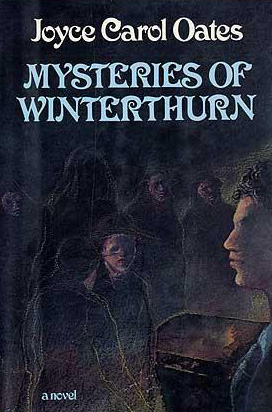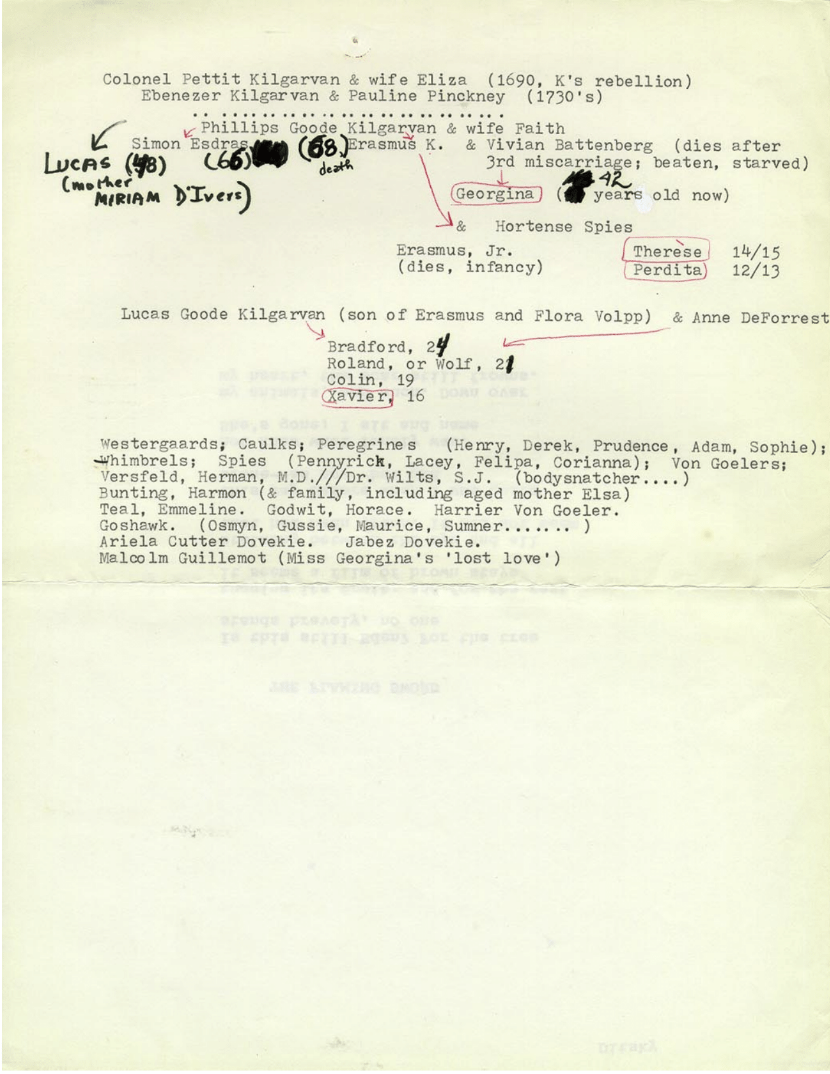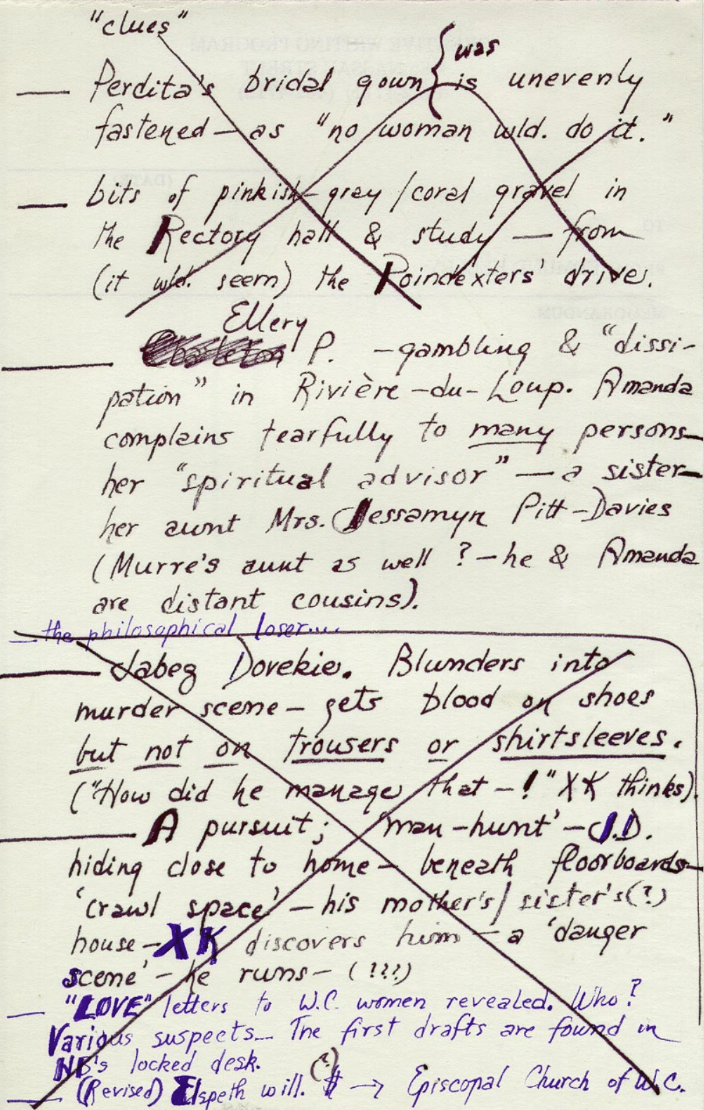By Joyce Carol Oates
New York: Dutton, 1984
482 pages
 Following the highly acclaimed Bellefleur (a gothic family saga) and A Bloodsmoor Romance (a romance), here is an extraordinary novel of mystery and murder—the third in Joyce Carol Oates’s ongoing sequence of novels that deals, in genre form, with nineteenth-century America. In Mysteries of Winterthurn, the detective-hero, Xavier Kilgarvan, is confronted with three baffling cases, all in Winterthurn, the place of his birth.
Following the highly acclaimed Bellefleur (a gothic family saga) and A Bloodsmoor Romance (a romance), here is an extraordinary novel of mystery and murder—the third in Joyce Carol Oates’s ongoing sequence of novels that deals, in genre form, with nineteenth-century America. In Mysteries of Winterthurn, the detective-hero, Xavier Kilgarvan, is confronted with three baffling cases, all in Winterthurn, the place of his birth.
Xavier’s first case, “The Virgin in the Rose-Bower,” coincides with his awakening adolescent passion for beautiful Perdita, a distant cousin. His investigations take him inside the ancestral mansion of the “rich” Kilgarvans, where a series of bizarre murders have occurred by night in the Honeymoon Room. Along with solving the crime, Xavier is forced to acknowledge a scandalous family secret, too shocking to be publicly revealed.
In the “Devil’s Half-Acre” case, Xavier, now twenty-eight and a detective of some professional stature, is confronted with the challenge of solving a series of brutal murders of local factory girls. (The prime suspect has been arrested, but Xavier is convinced that another, more aristocratic Winterthurn citizen is guilty.) Xavier’s efforts to see his nemesis convicted of murder have disquieting consequences. Disquieting, too, are the results of his ardent courtship of Perdita.
Then, at the age of forty, and at the very height of his fame, Xavier mysteriously withdraws form the profession of crime detection—after his obsessive struggle to solve the mystery of “The Bloodstained Bridal Gown.” In a number of surprising twists, Xavier is tested down to his very soul. He manages to unravel the grisly triple murder—and to resolve his longstanding passion for the enigmatic Perdita.
Mysteries of Winterthurn will fascinate lovers of mystery and appeal to readers with an interest in classic American murder cases of a bygone era. Its turbulent love story, with its romantic ending, will cast a haunting spell.
 Epigraph
Epigraph
“Depend upon it, Sir, when a man knows he is to be hanged in a fortnight, it concentrates his mind wonderfully.”
—SAMUEL JOHNSON
 Genre Series
Genre Series
“America as viewed through the prismatic lens of its most popular genres”
The novels in this series are written in the styles of genre fiction popular in the United States in the 19th and early 20th centuries, and are “linked by political, cultural, and moral … themes, set in a long-ago / mythic America intended to suggest contemporary times.” Each book is the story of a family intersecting, variously, with America’s troubled history of the treatment of women and children, and its battles over race and class divisions. These concerns are frequently translated into Gothic story elements (to varying degrees, depending on the novel), which is why these books are sometimes referred to as the “Gothic Series,” or the “Gothic Saga,” or the “American Gothic Quintet” Though thematically linked, each novel tells an independent story.
The Novels of the Genre Series:
- Bellefleur (1980) — Genre: historical novel / family saga 1770s–1980s
- A Bloodsmoor Romance (1982) — Genre: historical novel / romance 1879–1899
- The Accursed (2013) — Genre: historical novel / gothic horror 1900–1910
- Mysteries of Winterthurn (1984) — Genre: historical novel / detective mystery 1880s–1910s
- My Heart Laid Bare (1998) — Genre: historical novel / con artists and confidence games 1909–1932
“The opportunity might not be granted me again, I thought, to create a highly complex structure in which individual novels (themselves complex in design, made up of ‘books’) functioned as chapters or units in an immense design: America as viewed through the prismatic lens of its most popular genres.” —Joyce Carol Oates, 1985
 Contents
Contents
The Virgin in the Rose-Bower; or, The Tragedy of Glen Mawr Manor
Editor’s Note
Quicklime
Trompe L’Oeil
The Keening
The Spectacle in the Honeymoon Room
“Iphigenia”
Slaughtered Lambs
“If I-Am You-”
The Corpse
At Glen Mawr Manor: The Dungeon
The Lost Suitor
The “Little Nun”
“The Accursèd Kilgarvans”
The Fatal Wedding Night
At Glen Mawr Manor: The Attic
Felo-de-Se
Epilogue: Mr. Guillemot’s Testimony
Devil’s Half-Acre; or, The Mystery of the “Cruel Suitor”
Editor’s Note
Devil’s Half-Acre
“Damsels of the Half-Acre”
The Scent of Calla Lilies
“Our Accursèd Profession”
The Faithful Maiden
“. . . Your Adoring Cousin”
The Doomed Man
“Too Fast Have Those Young Days Faded”
At Ravensworth Park
Quicksand
In Courthouse Green
Postscript
The Traitor
“Let Your Light So Shine . . .”
Postscript
A Romantic Interlude
The “Cruel Suitor” Tried
The “Footman’s” Testimony
The “Cruel Suitor” Unmask’d
The “Cruel Suitor” Judged
The Turtle Dove’s Fate
Cousin Thérèse
Epilogue
The Bloodstained Bridal Gown; or, Xavier Kilgarvan’s Last Case
Editor’s Note
“. . . You Alone Are Our Salvation”
A Parenthetical Aside
“The Golden Vanity”
“The Red-Haired Specter”
In the Rectory
Lapis Lazuli
The Talk of the Town (I)
Xavier Kilgarvan’s Investigation: At St. Bride’s
Postscript
The Betrothal
Xavier Kilgarvan’s Investigation: The Embrace
Postscript: Xavier Kilgarvan’s Vow
The Talk of the Town (II)
Memento Mori
The Poisoned Benison
The Proposal
Xavier Kilgarvan’s Investigation: Hotel Paradise
The Honeymoon Cottage. Poindexter’s Defeat. The End.
Epilogue
 Excerpt
Excerpt
“Let us say, Xavier, that you have proved,—that is, you believe you have proved—that my client is guilty of the crime with which he has been charged. No, let us go a step further, for the sake of argument, and grant that you, with all your detectively skills, have proved his guilt; and that he is, indeed, guilty. Why, then, how can you not know,—you, who are a Kilgarvan, and a nephew of old Erasmus—that the challenge, for me, rises almost exclusively from that predicament?—which is to say, not the prosecutions’s ‘proof’ of guilt, but ‘guilt’ itself. Were the defendant innocent, and a verdict of not guilty naught but his just desert, how should I, Angus Peregrine, be allowed any  margin for genuine triumph? In such meager soil, what meager plants might grow? Nay, mere ‘justice’ no more excites me as a worthy goal than a game of poker in which all players possess equal skills, and identical cards . . . .”
margin for genuine triumph? In such meager soil, what meager plants might grow? Nay, mere ‘justice’ no more excites me as a worthy goal than a game of poker in which all players possess equal skills, and identical cards . . . .”
. . . Xavier said: “But then, is not your life criminal too? Is it not predicated upon lies, hypocrisy, and subterfuge of every sort? For, by your own acknowledgment, you prefer guilty clients; you are most comfortable with crime; and derive your energies from it. How would you defend your life, erected upon such a foundation?”
Whereupon Angus Peregrine said, after a moment’s unclouded reflection: “My life, Xavier, and my professional career, must not be confused. For the one has not invariably to do with the other; I hope I have the wit to keep them distinctly separate—! And you—?”
Xavier winced at this friendly query, as if it gave him pain; and replied, in a singularly slow, halting, benumbed voice: “My life and my professional career are, —are—one and the same.” So saying, he drained the champagne from his glass without tasting it; as if the knowledge of his unique doom had struck him only at that moment. “One and the same.”
 Preface: Mysteries of Winterthurn
Preface: Mysteries of Winterthurn
Excerpt from “Five Prefaces” in (Woman) Writer: Occasions and Opportunities 
Mysteries of Winterthurn is the third in a quartet of experimental novels that deal, in genre form, with 19th-century and early 20th-century America. A family saga (Bellefleur, 1980), a romance (A Bloodsmoor Romance, 1982), a detective-mystery (Mysteries of Winterthurn, 1984), a Gothic horror set in turn-of-the-century Princeton (The Crosswicks Horror, forthcoming [eventually published as The Accursed])—the novels, thematically linked, might be described as post-modernist in conception but thoroughly serious in execution. Primarily, each novel tells a story I consider uniquely American and of our time. The characters of the quartet are both our ancestors and ourselves.
But why “genre,” one might ask? Does a serious writer dare concern herself with “genre”? Why, in imagining a quartet of novels to encompass some six decades of American history (beginning in the remarkable 1850s in Bloodsmoor), and to require some two thousand pages of prose—(the romance being, of necessity, the longest of the four)—why choose such severe restraints, such cruelly confining structures? But the formal discipline of “genre“—that it forces us inevitably to a radical re-visioning of the world and of the craft of fiction—was the reason I found the project so intriguing. To choose idiosyncratic but not distracting “narrators” to recite the histories; to organize the voluminous materials in patterns alien to my customary way of thinking and writing; to “see” the world in terms of heredity and family destiny and the vicissitudes of Time (for all four novels are secretly fables of the American family); to explore historically authentic crimes against women, children, and the poor, in the guise of entertainment; to create, and to identify with, heroes and heroines whose existence would be problematic in the clinical, unkind, and one might almost say, fluorescent-lit atmosphere of present-day fiction—these factors proved irresistible. The opportunity might not be granted to me again, I thought, to create a highly complex structure in which individual novels (themselves complex in design, made up of “books”) functioned as chapters or units in an immense design: America as viewed through the prismatic lens of its most popular genres. The sequence begins with a quotation attributed to Heraclitus (“Time is a child playing a game of draughts; the kingship is in the hands of a child”) at the start of Bellefleur, and ends with the concluding section, a sermon, in The Crosswicks Horror. But the novels, in any case, are independent of one another so far as the experience of reading is concerned.
The three cases that constitute Mysteries of Winterthurn are variations on the enigma of mystery itself. In “The Virgin in the Rose-Bower,” the detective seeks to discover who has committed the murders, and why; in “Devil’s Half-Acre” the identity of the probable murderer is less uncertain than whether, granted the prejudices of his society, he can be brought to justice. The special puzzle of “The Bloodstained Bridal Gown” has to do with the detective’s inability to solve the crime when various clues and motives will strike the attentive reader as self-evident. In the laconic words of Poe’s Monsieur Dupin “Perhaps it is the very simplicity of the thing that puts you at fault.”
Xavier Kilgarvan as idealist and lover is the quintessence of the late 19th-century sensibility. From boyhood onward he is fascinated by the prospect of mystery and its “solution” or exorcism; his imagination is inflamed by the obdurate nature of certain puzzles: why? where? who? with what consequences? He is thoroughly American in his zeal to make a distinguished name for himself, and the buoyant optimism to which he confesses (“crime, if not the criminal heart itself, might someday be eradicated by the intellectual, pragmatic, and systematic unification of the numerous forces for Good”) is in the spirit of mid- and late 19th-century dreams of progress. Xavier comes of age and begins his rather glamorous professional career in those decades in which a passionate belief in evolution (in society and morals no less than in Nature) was widely shared by men and women of education, intelligence, and sensitivity. He withdraws from his career—for mysterious but privately logical reasons—not long before the collapse of these dreams with the outbreak of the Great War. So far as Xavier’s personal story is concerned, it might be seen to end happily, or tragically, or ironically, or, indeed, wisely, depending upon one’s point of view.
Aficionados of classic American murder cases will recognize here, in transmogrified and modulated forms, certain old favorites about which I dare not be more specific, for fear of revealing too much. The fictional cases are meant to bear a sort of dreamlike (or nightmarelike) relationship to the originals, one or two of which have never been satisfactorily solved; but they have been chosen because they deal with ongoing themes of the quartet—the wrongs perpetrated against women, for instance, and the vicious class and race warfare that has constituted much of America’s domestic history. Xavier Kilgarvan is a fictitious person, but in many ways he follows the pattern of the 19th-century “amateur” detective, tireless in his research into the latest forensic discoveries, pioneering in a new and undefined and thoroughly exciting profession. (It is quite likely, for instance, that a promising young man with Xavier’s ambition would visit the Paris Sûreté and speak with the famous Alphonse Bertillon, and that he would be treated kindly by Scotland Yard—men with a penchant for detective work, whether associated with police forces or not, constituted an informal brotherhood within a great sea of ignorance, incompetence, and corruption.)
Yet Xavier’s temperament is also that of an artist. His cases are, perhaps, stories, parables, “mysteries” that yield their meaning only after much frustration and mental anguish . . . the meaning being the very pattern of the work of art, its voice, its tone, its spirit. Hence my feeling of intense identification with him, and my sense that, at this time at least, Mysteries of Winterthurn is my favorite among my own novels.
 Awards
Awards
- New York Times Notable Books of the Year
 Manuscript Images
Manuscript Images
All manuscript images are in pdf format.
Images may not be reproduced without permission of Joyce Carol Oates.

“how, how to organize this welter of material…!”

Early versions of the “Author’s Note” to the first mystery.

Hand-drawn map of Winterthurn City. Likely hung over JCO’s desk during composition of the novel.

Table of contents to The Bloodstained Bridal Gown, appropriately written in blood (or perhaps red ink).

“Angels may turn demons …” Working out an important theme of the novel.

Early musings: “Mysteries of Winterthur”; “Sherlock Holmes”; “My spiritual autobiography”

Crossed-out notes on the first mystery, and Simon Esdras. Doodled faces.

Kilgarvan family tree, and important characters.

Creating Georgina’s poetry.

“Clues” to the final mystery.
(spoilers here: read at your own risk)

Lists of potential names, both character and place. Mysteries of Solebury County … interesting.

Outlining the second mystery.
 More manuscript Images
More manuscript Images
 Reviews
Reviews
Anne Bernays, Boston Globe, February 12, 1984, Review, p. 1

Lorna Sage, Times Literary Supplement, July 20, 1984, p. 801

“What Oates is doing, in leisurely and titillating fashion, is concocting radically ambiguous, undecidable stories, in which empirical hopes and metaphysical fears encounter each other head on, inscribed in one and the same set of signs.”
Ingrid H. Shafer, National Catholic Reporter, November 16, 1984, p. 12

“Mysteries of Winterthurn is a work of haunting intensity, brilliantly conceived and executed, a terrifying portrait of a fallen world. And yet, as one senses the presence of light in the empirical datum of darkness, this phenomenology of the demonic hints at a mysterious presence of quite another kind, the ultimate paradox that shatters all finite categories of reason.”
Publisher’s Weekly, December 23, 1983, p. 49

“…ripping fine yarns for those who like them gory and garish, and for insiders a thick, campy literary joke composed of gaslit theatrics and stylistic pyrotechnics.”
Beth Ann Mills, Library Journal, January 1984, p. 111

Reversing the traditions of detective fiction, however, Oates presents not Kilgarvan’s successes, but his failures …. Allusive, riddling, frustrating yet thought provoking ….
Charles Champlin, Los Angeles Times Book Review, January 8, 1984, p. 1

For her limitless energy, the fecundity of her imagination and the persistence of her vision, highest marks; for Oates’ choice this time of a literary voice, lower marks.
Alan Ryan, Washington Post Book World, January 22, 1984, p. 7

“This book might more properly be read the way our grandparents read books—or, more properly still, the way our grandmothers read books: as if each one were hugely special, to be tasted slowly and savored fully, in a leisurely fashion, allowing full play to the author’s style and storytelling skill and our own willingness to follow where we are lead, no matter the shocking consequences—in fact, the more shocking, the better.”
Bruce Allen, Christian Science Monitor, February 1, 1984, p. 19

”Winterthurn” abounds with inspired steals from American and British history and literature: Jack the Ripper, the Rosenberg case, Emily Dickinson, Charles Brockden Brown’s ”Wieland,” and Hawthorne’s ”The Blithedale Romance” are among sources the attentive reader will find here, playfully transmogrified. … This novel is essentially an entertainment, and I’d say that anyone who can handle the slow style and can enjoy stories that develop and exfoliate at leisure should find it one of Oates’s most accessible books.
Anne Collins, Maclean’s, February 20, 1984, p. 60

But in the detective story Oates has at last found a 19th-century form in which she can thoroughly entertain her reader. The pose of objectivity she must adopt to properly portray her hero, Xavier Kilgarvan, is an effective leash on florid narrative. Her mock objectivity is also a never-ending font of pleasing irony, because the true mysteries of Winterthurn are the kind that can never be solved by rational thought.
Anne V. Kish, Best Sellers, March 1984, pp. 440-441

Linda W. Wagner, Michigan Quarterly Review, Summer 1984, pp. 446-451

Rushing from bizarre episode to grotesque finale … Mysteries of Winterthurn is a novel hard to put down. … Oates has learned her craft from the masters of modern fiction—Faulkner, Joyce, Lawrence, Nabokov, Kafka—and what she has learned best is how to submerge her own personality to the persona (the double persona, character and author) of the book she is writing. Her chameleon-like “self” has bothered most of her reviewers through the years, but it seems as if it is time to acknowledge her talent for mimicry, as well as her vast fund of understanding about literature of all kinds, and applaud an experimental fiction like Mysteries.
Robert Nye, Guardian, June 21, 1984, p. 9

Matthew David Surridge, Black Gate, October 15, 2012

As a story, much of the success of the book has to hang on Xavier’s appeal as a character. And in that, I think Oates has found a detective both interesting and sympathetic. … Oates is able to get across the sense of a fascinating figure defined by powerful contradictions: a determined, even driven man, but also a man who is in many ways broken. … /In all, it’s a powerful book, unsettled and unsettling.
Eloise Salholz, Newsweek, February 6, 1984, p. 79

…in her second tale, “Devil’s Half-Acre,” Oates addresses those moral questions quite brilliantly. She chillingly evokes the evil of small-town bigotry and limns a marvelously malevolent, elegant villain. It is here, too, that the author’s best prose shines through. By her third mystery … “Mysteries of Winterthurn” is once again choked by excesses of plot and excrescences of prose.
Derrick Murdoch, Globe and Mail (Canada), February 11, 1984

Patricia Craig, New York Times Book Review, February 12, 1984, p. 7

Miss Oates makes no bones about confounding the reader’s expectations in the effort to reinstate “Mystery” as a kind of philosophical category. She offers no mundane solutions to her crimes, conjuring will-o’-the-wisps and cherishing ambiguity. (This is a novel with many secrets, and it keeps a number of them to itself.) It is easy enough to identify the typical lurid three-decker novel of the last century as Miss Oates’s starting-point. After all, she’s done this sort of thing in “Bellefleur’ and “A Bloodsmoor Romance.” But at times it’s unclear to the reader whether she’s reproducing a 19th-century detective novel, overturning it, expanding it or sending it up.
Faye Hunter, San Diego Union-Tribune, March 18, 1984, Books, p. 3

There is no real resolution in this novel. We only get a look at the mystical happenings in Kilgarvan’s life and how they intertwine into the culture and the daily lives of the prominent families of Winterthurn. But this is entertaining writing. The mystery involved in the old-fashioned telling of these murders pulls the reader along through the pages. And there is a happy ending, though not in the traditional crime novel sense.
R. Beards, World Literature Today, Winter 1985, p. 103

…the citizenry of Winterthurn need to execute the innocent in order to maintain social and economic life. Though this theme is muted by the charm and elegance of the author’s presentation, it cannot be ignored as the essential idea of the novel.
Kirkus Reviews, December 1, 1983, p. 1221

Another verbose quasi-period concoction from the alarmingly prolific Oates—with little of the wit and thematic edge that made A Bloodsmoor Romance a pointed (if labored) diversion.
Michiko Kakutani, New York Times, February 10, 1984, p. C25

Given the achievement of ”Bellefleur” and ”A Bloodsmoor Romance,” one assumes that Miss Oates set out, with ”Mysteries” to write a book that at once satirizes a popular genre and fulfills its own storytelling requirements. If she is heavy-handed in achieving her first objective, however, she is even clumsier with the second.
New Yorker, February 27, 1984, p. 133

Brandon Russell, Spectator, July 14, 1984, pp. 29-30

But whereas Poe’s stories are satisfactorily resolved, the three collected here by the book’s unidentified ‘Editor’ are blatantly unresolved. The celebration of Mystery, in fact, is little more than an excuse to mystify the reader.
Daniel J. Langton, San Francisco Chronicle Book Review, January 8, 1984, p. 1

What we have is tentativeness of place, of authoritative storytelling, italics everywhere, and weird mistakes. … No, when all’s said it is a substandard romantic blather, and rather misbegothic at that.
Observer, June 24, 1984, p. 21
Listener, July 12, 1984, p. 28
Fantasy Review, September, 1984, p. 33
 Image: William Bradley — Victor Bicycles, Overman Wheel Co, c.1895
Image: William Bradley — Victor Bicycles, Overman Wheel Co, c.1895
 Image: Alphonse Mucha — Cycles Perfecta, c. 1902
Image: Alphonse Mucha — Cycles Perfecta, c. 1902

 Following the highly acclaimed Bellefleur (a gothic family saga) and A Bloodsmoor Romance (a romance), here is an extraordinary novel of mystery and murder—the third in Joyce Carol Oates’s ongoing sequence of novels that deals, in genre form, with nineteenth-century America. In Mysteries of Winterthurn, the detective-hero, Xavier Kilgarvan, is confronted with three baffling cases, all in Winterthurn, the place of his birth.
Following the highly acclaimed Bellefleur (a gothic family saga) and A Bloodsmoor Romance (a romance), here is an extraordinary novel of mystery and murder—the third in Joyce Carol Oates’s ongoing sequence of novels that deals, in genre form, with nineteenth-century America. In Mysteries of Winterthurn, the detective-hero, Xavier Kilgarvan, is confronted with three baffling cases, all in Winterthurn, the place of his birth. margin for genuine triumph? In such meager soil, what meager plants might grow? Nay, mere ‘justice’ no more excites me as a worthy goal than a game of poker in which all players possess equal skills, and identical cards . . . .”
margin for genuine triumph? In such meager soil, what meager plants might grow? Nay, mere ‘justice’ no more excites me as a worthy goal than a game of poker in which all players possess equal skills, and identical cards . . . .”











 Reviews
Reviews Image:
Image:
Gosh, I love this post. So comprehensive and compelling. I just finished reading “48 Clues.” Wonderful!
LikeLiked by 1 person
thanks, Randy! my favorite novel of my own, I think.
warmly
Joyce
LikeLiked by 1 person